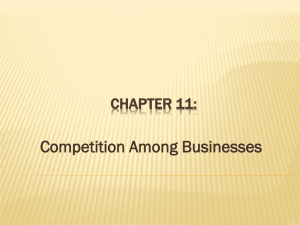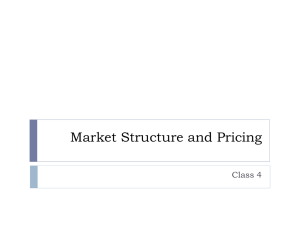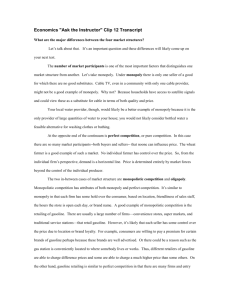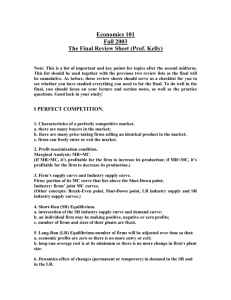Unit IV- Forms of Market Structure
advertisement
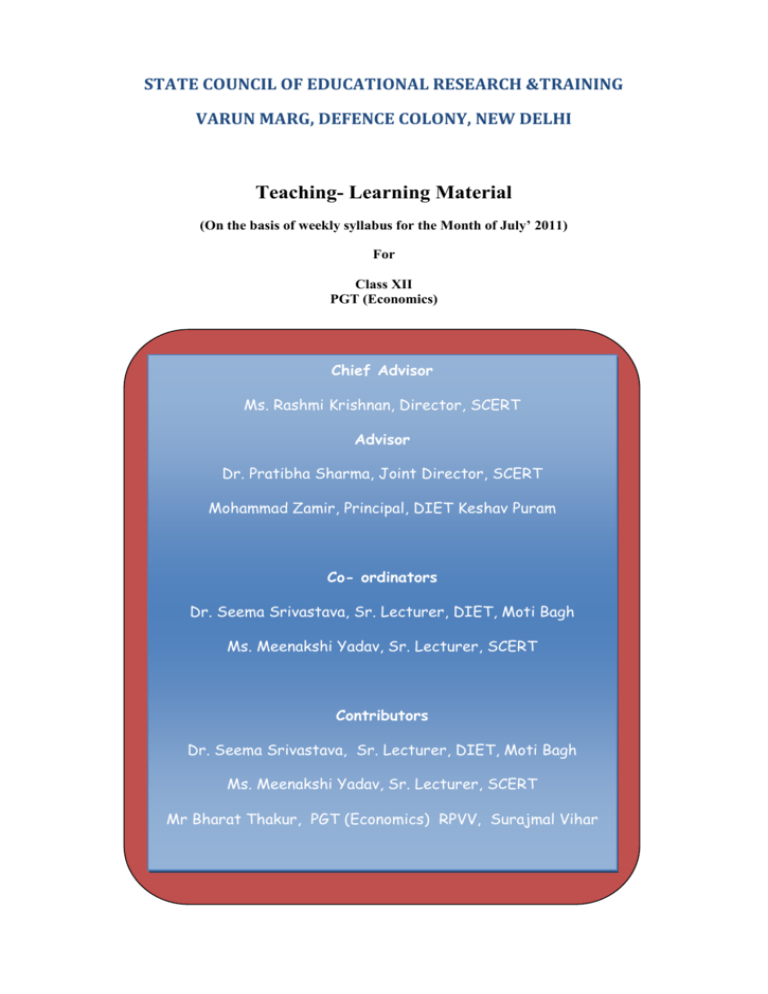
STATE COUNCIL OF EDUCATIONAL RESEARCH &TRAINING VARUN MARG, DEFENCE COLONY, NEW DELHI Teaching- Learning Material (On the basis of weekly syllabus for the Month of July’ 2011) For Class XII PGT (Economics) Chief Advisor Ms. Rashmi Krishnan, Director, SCERT Advisor Dr. Pratibha Sharma, Joint Director, SCERT Mohammad Zamir, Principal, DIET Keshav Puram Co- ordinators Dr. Seema Srivastava, Sr. Lecturer, DIET, Moti Bagh Ms. Meenakshi Yadav, Sr. Lecturer, SCERT Contributors Dr. Seema Srivastava, Sr. Lecturer, DIET, Moti Bagh Ms. Meenakshi Yadav, Sr. Lecturer, SCERT Mr Bharat Thakur, PGT (Economics) RPVV, Surajmal Vihar Support Material For Teachers In Economics – Class XII Co-ordinators Dr. Seema Srivastava Ms. Meenakshi Yadav Contributors Dr. Seema Srivastava Ms. Meenakshi Yadav Mr.Bharat Thakur Technical Support Mr.V.K.Sodhi Ms.Sapna Yadav Ms.Radha Ms.Garima Ms.Ritu Class – XII Teaching -Learning Material for PGT (Economics) Based on “Week- Wise Distribution of Syllabus 2011 -2012” For the Month of July: Unit-IV (18.07.2011 – 25.07.2011) 7 days (25.07.2011-30.07.2011) 6days Abstract Present unit deals with the Concept of Market Structure which comprises of different market conditions under which the firms produce and sell products in the market. The unit also elaborates upon various Forms of Market Structure such as Perfect Market and * Imperfect Market (*Monopoly, Monopolistic Competition and Oligopoly). The conditions and determination of price under various Forms of Market Structure have been discussed. The content based classroom activity has been suggested at the end. It will help in developing Critical Thinking & Analytical ability among students which is the demand of this subject. Questions based on the content to check the progress have been included. Different types of Questions such as Very Short Answer Type, Short Answer Type, and Long Answer Type questions (based on Board pattern) are also given under' Additional Questions’. List of URL’s have been mentioned in the end. You are requested to search those web links for more interesting details about the unit covered in the present module. This will enable you to develop more interesting Teaching- Learning Classroom Processes for children. Learning objectives After going through the material/ unit you will be able to: 1. Define the term ‘Market Structure’. 2. State the Elements of Market structure. 3. Explain the Determinants of Market Structure. 4. Classify various Forms of Market Structure. 5. Define Perfect and Imperfect forms of market. 6. Explain the features/Characteristics of Perfect, Monopoly, Monopolistic and Oligopoly forms of market. 7. Draw and Interpret shapes of AR and MR Curves under Various forms of Market Structure. 8. Compare various forms of Market Structure. Teaching Points Concept of Market Structure Elements of Market Structure Determinants of Market Structure Forms of Market Structure: (Concept& Features) 1) Perfect Competition 2) Monopoly 3) Monopolistic Competition 4) Oligopoly Comparison/Summary of Market Structures Market Structure and Forms of Market 1. Market Structure Market Structure is also known as the number of firms producing identical products. Firm sells goods and services under different market conditions which economists call Market Structures. A Market Structure describes the key traits of a market, including the number of firms, the similarity of the products they sell, and the ease of entry into and exit from, the market examinations of the business sector of our economy reveals firms’ operating in different Market Structure. Market Structure is best defined as the organizational and other characteristics of a market. These characteristics affect the nature of competition and pricing. 1.1 Elements of Market Structure 1. Number and size, Distribution of Firms 2. Entry Conditions 3. Extent of Product Differentiation Types of Market Structure influences how a firm behaves regarding the following: Price Supply Barriers to Entry Efficiency Competition 1.2 Determinants of Market Structure Freedom of Entry and Exit Nature of the Product: Homogeneous or Differentiated Control over Supply /Output Control over Price Control to Entry 2. Forms of Market Main Forms of Markets | |________________________________| Perfect Market Imperfect Market | |_____________________________|____________________________| Monopoly Monopolistic Competition Oligopoly 3. Perfect Competition Perfect Competition is a theoretical Market Structure that features unlimited contestability (No barriers to enter) and unlimited number of producers and consumers, and a Perfect Elastic Demand Curve. Perfect competition is a market structure where an infinitely large number of buyers and sellers operate freely and sell a homogeneous commodity at a uniform price. 3.1 Features of Perfect Competition 1. Infinitely Large number of Buyers and Sellers When there is very large number of buyers no individual buyer can influence the market price. Similarly when there are a very large number of sellers, each firm or seller in a perfectly competitive market forms an insignificant part of the market. Therefore, no single seller has the ability to determine the price at which the commodity is sold. So who determines the price in such a market? In a perfectly competitive market, it is the forces of Market Demand and Market Supply that determines the price of the commodity. Since each firm accepts the price that is determined by the market, it becomes a Price Taker. As the market determines the Price, it is the Price Maker. Example-1 Table- 1 Market Demand and Supply Price per Unit (Rs.) 10 20 30 40 50 Demand (Units) Supply (Units) 1000 900 800 700 500 650 800 950 600 1100 Diagram showing Market is Price Maker and Firm is Price Taker In the Table and Diagram above, the forces of demand and supply equalize at a price of Rs. 30 per unit. This is the Market Determined Price under Perfect Competition. Once the market determines the price, each firm accepts it. No firm in its individual capacity can alter the price given to it by the market. If any firm were to change a price higher than market determined price, buyers would shift to another firm. No firm would like to charge a price lower than the market determined price, as by doing so it loses revenue. 2. Homogenous Product In a perfect competitive market, firms sell homogeneous products. Homogenous products are those that are identical in all respects i.e. there is no difference in packaging, quality colors etc. As the output of one firm is exactly the same as the output of all others in the market, the products of all firms are perfect substitute for each other. 3. Free Entry in to and Exit from the market Very easy entry into a market means that a new firm faces no barriers to entry. Barriers can be financial, technical or government imposed barriers such as Licenses, Permits and Patents. The implication of this feature of Perfect Competition is that while in the short run firms can make either supernormal profits or losses, in the long run all firms in market earn only normal profits. 4. Perfect Knowledge of Market Buyers and sellers have complete and perfect knowledge about the product and prices of other sellers. This feature ensures that the market achieves a uniform price level. 3.2 Shape of the AR and MR curves under Perfect Competition Since the firm under Perfect Competition is a Price Taker and cannot change the price it can change for its product, the Average Revenue (which is equal to price) is the same for all units of output sold. In this case, Marginal Revenue is also constant and equal to the Average Revenue. Average Revenue Curve is also a Demand Curve facing a perfectly competitive firm, which is perfectly elastic. No real world market exactly fits the features of perfect market structure is a theoretical or ideal model, but some actual markets do approximate the model fairly closely. Examples of Perfect Competition include firm products markets, the Stock Market and Foreign Exchange Market, Currency Market, Bond Market. . 4. Monopoly Pure Monopoly is the form of market organization in which there is a single seller of a commodity for which there are no close substitutes. Thus, it is at the opposite extreme from perfect competition monopoly may be the result of: (1) Increasing returns to scale; (2) Control over the supply of raw materials; (3) Patents; (4) Government Franchise. 4.1 Features 1. A Single Seller There is only one producer of a product. It may be due to some natural conditions prevailing in the market, or may be due to some legal restriction in the form of patents, copyright, sole dealership, state monopoly, etc. Since, there is only one seller; any change in supply plans of that seller can have substantial influence over the market price. That is why a Monopolist is called a Price Maker. (A Monopolist’s influence on the market price is not total because the price is determined by the forces of Demand and Supply and the Monopolist controls only the supply). 2. No Close substitute The commodity sold by the Monopolist has no close substitute available for it. Therefore, if a consumer does not want the commodity at a particular price, he is likely to get available closely similar to what he is giving up. For example, there are chapters you have studied that the availability of substitute goods impact. The elasticity of demand for a product since the product has no close substitutes; the demand for a product sold by a monopolist is relatively inelastic. 3. Barriers to the entry of new firms There are barriers to entry into industry for the new firms. It may be due to following reasons: (i) Ownership of strategic raw material or exclusive knowledge of production (ii) Patent Rights (iii) Government Licensing (iv) Natural Monopolies The implication of barriers to entry is that in the short run, monopolist may earn supernormal profit or losses. However, in the long run, barriers to entry ensure that a monopolistic firm earns only super normal profits. 4. Price Discrimination Price Discrimination exists when the same product is sold at different price to different buyers. A monopolist practices price discrimination to maximize profits. For example Electricity Charges in Delhi are different for Domestic users and Commercial and Industrial users. 5. Abnormal Profits in the Long run Being the single seller, monopolists enjoy the benefit of higher profits in the long run. 6. Limited Consumer Choice As they are the single producer of the commodity, in the substitute the choice for consumer is limited. absence of any close 7. Price in Excess of Marginal Cost Monopolists fix the price of a commodity (per unit) higher than the cost of producing one additional unit as they have absolute control over Price Determination. 4.2 Shape of the AR and the MR Curves under Monopoly The AR Curve faced by the Monopolistic is Downward Sloping as the Monopolist can increase sales by reducing price. If the AR Curve is declining, it implies that the MR is also declining at a faster rate. 4.3 Demand Curve facing the Monopolist Since there is only one seller in the market, the AR Curve of a monopolist in nothing else but the Market Demand Curve for the product. The demand is relatively inelastic as there is only a single seller for the commodity and its product does not have close substitutes. 5. Monopolistic Competition Monopolistic competition is a situation in which the market, basically, is a competitive market but has some elements of a monopoly. In this form of market there are many firms that sell closely differentiated products. The examples of this form of market are Mobiles, Cosmetics, Detergents, Toothpastes etc. 5.1 Features 1. Large number of buyers and sellers In this form of market, while the buyers are as large as it is under perfect competition or monopoly, the number of sellers is not as large as that under perfect competition. Therefore, each firm has the ability to alter or influence the price of the product it sells to some extent. 2. Product Differentiation Under Monopolistic Competition products are differentiated. This means that the product is same, brands sold by different firms differ in terms of packaging, size, color, color features etc. For example-soaps, toothpaste, mobile instruments etc. The importance of Product Differentiations is to create an image in the minds of the buyers that the product sold by one seller is different from that sold by another seller. Products are very similar to each other, but not identical. This allows substitution of the product of one firm with that of another. Due to a large number of substitutes being available Demand for a firm’s product is relatively elastic. 3. Selling Costs As the products are close substitutes of each other, they are needed to be differentiate for this firms incurs selling cost in making advertisements, sale promotions, warranties, customer services, packaging, colors are brand creation. 4. Free Entry and Exit of firm Like perfect competition, free entry and exit of firms is possible under this market form. Since there are no barriers to entry and exit, firms operating under Monopolistic Competition, in the long run, earn only normal profits. 5.2 Shape of the AR and MR Curves under Monopoly Under Monopolistic Competition, like monopoly, both the AR and MR curves are downward sloping. A downward sloping AR curve implies that in order to sell more units of the output the price of the commodity needs to be reduced. However, the AR and MR curves are flatter under monopolistic competition than under Monopoly because of the large number of close substitutes available for a firm’s output. (AR and MR Curves under Monopoly) 5.3 Demand Curve under Monopolistic Competition The AR curve is nothing else but the demand curve faced by a firm. The demand curve is also downward sloping. This implies that buyers are willing to buy more of a commodity only if its price is reduced. As the large number of close substitute is available for a firm’s product, the demand curve faced by a monopolistically competitive firm is relatively elastic. 6. Oligopoly The term Oligopoly means ‘Few Sellers’. An Oligopoly is an industry composed of only few firms, or a small number of large firms producing bulk of its output. Since, the industry comprises only a few firms, or a few large firms, any change in Price and Output by an individual firm is likely to influence the profits and output of the rival firms. Major Soft Drink firms, Airlines and Milk firms can be cited as an example of Oligopoly. 6.1 Features 1. A Few Firms Oligopoly as an industry is composed of few firms, or a few large firms controlling bulk of its output. 2. Firms are Mutually Dependent Each firm in oligopoly market carefully considers how its actions will affect its rivals and how its rivals are likely to react. This makes the firms mutually dependent on each other for taking price and output decisions. 3. Barriers to the Entry of Firms The main cause of a limited number of firms in oligopoly is the barriers to the entry of firms. One barrier is that a new firm may require huge capital to enter the industry. Patent rights are another barrier. 4. Non Price Competition When there are only a few firms, they are normally afraid of competing with each other by lowering the prices; it may start a Price War and the firm who starts the price war was may ultimately loose. To avoid price war, the firm uses other ways of competition like: Customer Care, Advertising, Free Gifts etc. Such a competition is called non-price competition. 7. Summary of Market Structures Sr.No. Characteristics Perfect competition 1. Number of Many Firms 2. Types of Homogeneous Product 3. 4. 5. 6. Monopoly Monopolistic Oligopoly One Unique/ Single/ Limited Entry condition Very easy Impossible Pricing Price Taker Price Maker Innovative Weak Potentially Behavior strong Examples Agriculture, Public Stock Market, Activities. Currency Market, Bond market Many Few Differentiated Differentiated Easy Price Taker Difficult Price maker Moderate Very Strong Retail Trade Steel, Oil, Milk, Soft Drinks, Airlines Classroom Activity While teaching the Forms of Market i.e., Perfect Competition, Imperfect Competition (Monopoly, Monopolistic, Oligopoly), focus on the comparison, analysis of market conditions, price distribution and other conditions, price determination and other characteristics of each form. Later for developing Critical Thinking based on Analytical Ability, students can be divided in four groups, i.e. Perfect Competition, Monopoly, Monopolistic, Oligopoly and then ask each group to prepare as much material as possible including Prize Distribution, Entry Conditions, Cost and Revenue Curve, Short and Long -Term implications Examples etc. Then, the role of teacher will be that of a Facilitator, when each group presents, discusses and compares on each criteria under the category they are placed. After the entire unit 4 is taught, you may follow the following steps in organizing the activity in the class room: Divide the whole class into four Market Structures i.e. Perfect Competition, Monopoly, Monopolistic, Oligopoly i.e. Team A, B, C and D respectively 1. Give them time to prepare for their own assigned form. During the classroom time they should sit in their respective groups and prepare and collect as much information as much possible including presentations. (Announce the class that there will be Quiz, at the end of all presentations or next day.) 2. Teacher should prepare the areas/parameter of discussion i.e. (i) Prize Determination under each form (ii) Entry Conditions (iii) Shape and nature of AR/ MR firms under each form (iv) Short term/long term implication etc. Likewise based on content, add the parameters on which discussions can take place in the class. With the help of some good students (or the teacher teaching the same subjects in the school) make ‘Quiz Questions’ like any other quiz. Write questions on hard board, (place in file), make Time keeper, Score Keeper who will assist you in organizing the ‘quiz ‘effectively. (Make adequate number of questions for minimum ‘3’ rounds of Quiz)’. Conclude by giving away participation certificate to all participants, some incentive/reward to winning team. This will create interest in the subject among the students. It will also develop a healthy, competitive spirit and analytical ability based on Critical Thinking. Summary A Market Structure describes the Key Traits of a market, including the number of firms, the similarity of the products they sell, and the ease of entry into and exit, from the market examinations of the business sector of our economy reveals firms’ operating in different market structure. Elements of Market Structure are 1. Number and size, Distribution of Firms 2. Entry Conditions 3. Extent of Product Differentiation. Determinants of Market Structure include: Freedom of Entry and Exit, Nature of the Product, Homogeneous or Differentiated, Control over Supply /Output, Control over Price, Control to Entry. Different Forms of Market are: Perfect Competition and* Imperfect Competition (*Monopoly, Monopolistic Competition, and Oligopoly) Perfect competition is a theoretical Market Structure that features unlimited contestability, an unlimited number of producers and consumers, Homogeneous Products ,Free Entry and Exit and perfect knowledge of Market. Monopoly, where there is only one provider of a product or service. Features of this form of Market include: No Close Substitute, Barriers to the Entry of new Firms, Price Discrimination, Abnormal Profits in the long run, Limited Consumer Choice, Prices in excess of MC .Monopolistic competition, also called competitive market, where there are a large number of firms, each having a small proportion of the market share and slightly differentiated products and Firms can easily enter and exit from the Market. Oligopoly, in which a market is dominated by a small number of firms that are mutually dependent that together control the majority of the market share. In this form of market it is difficult for the new Firms to enter. When there are only a few firms, they are normally afraid of competing with each other by lowering the prices; it may start a Price War and the firm who starts the price was may ultimately loose. To avoid price war, the firm uses other ways of competition line customer care, advertising, free gifts etc. Such a competition is called non-price competition. Technical Terms Market Structure A Market Structure describes the key traits of a market, including the number of firms, the similarity of the products they sell, and the ease of entry into and exit from, the market examinations of the business sector of our economy reveals firms’ operating in different Market Structure. Perfect Competition Perfect competition is a market structure where an infinitely large number of buyers and sellers operate freely and sell a homogeneous commodity at a uniform price. Monopoly Pure monopoly is the form of market organization in which there is a single seller of a commodity for which there are no close substitutes. Monopolistic competition: Monopolistic competition is a situation in which the market, basically, is a competitive market and there are many firms that sell closely differentiated products. Oligopoly An Oligopoly is an industry composed of only few firms, or a small number of large firms producing bulk of its output. Check your Progress 1. What is the relevance of large number of sellers under Perfect Competition? 2. The MR Schedule of a Monopoly firm is given below. Derive the TR and AR schedules Output (units) 0 MR (Rs.) - 1 14 2 10 3 7 4 5 5 0 6 -3 7 15 3. Discuss various ways in which a Monopoly market structure may arise. 4. Why is the demand curve facing a monopolistic competitive firm likely to be very elastic? 5. Explain the following:(a) “Free Entry and Exit” Feature of Perfect Competition. (b) “Differentiated products” features of Monopolistic Competition. 6. Compare and contrast the features of Monopoly and Oligopoly. 7. What is Product Differentiation? What is the significance of Product Differentiation in monopolistic competition? 8. Draw the AR Curve of a firm under (i) Monopoly (ii) Monopolistic Competition and Perfect Competition. Explain the difference in these curves. Additional Questions Very Short Answer Type Questions 1. Under which market form is a firm Price Taker? 2. Draw a Demand Curve under Perfect Competition. 3. Define the term ‘Equilibrium Price’. 4 .When does the situation of Excess Supply arise? 5. What is the Profit Maximization condition for Perfect Competition? Short Answer Type Questions 1. Why is a Firm under Perfect Competition a Price Taker? 2. Explain three features of Perfect Competition. 3. Explain the determination of Equilibrium Price under Perfect Competition with the help of a schedule. 4. Show that an increase in demand leads to a fall in the price of the commodity. 5. Diagrammatically represent the impact of a decrease in Supply on Equilibrium Price and of Quantity, when demand is perfectly elastic. 6. What will be the impact of increase in Excise duty on the Equilibrium Price and Quantity of a commodity? Use diagram to explain. 7. Explain the features “Large number of firms and Buyers” under Perfect Competition Long Answer Type Question /Essay Type Questions 1 .How does an increase in price of Steel affect the equilibrium price and quantity of cars? Explain with the help of diagram 2. With the help of a diagram explain how a rise in the Income levels impact the equilibrium price of Shirts? 3. There is Simultaneous change in the demand and supply of a commodity and equilibrium price increases. Explain this with the help of a diagram. 4. Explain the following features of Perfect Competition: Large number of Firms and Buyers Homogeneous Product URL’s Perfect competition http://www.metacafe.com/watch/3810573/perfect_competition/ Equilibrium in perfect Competition http://www.youtube.com/watch?v=7lhX78vlHSY Perfect competition http://www.schooltube.com/video/375fef99356c4cc7aa38/Business-Model-PerfectCompetition Free Market Economy http://www.youtube.com/watch?v=4YwUnjqsIQM Four Market Structures Simulation http://www.youtube.com/watch?v=KGrmnynjHjI Episode 25- Market Structures http://www.youtube.com/watch?v=9Hxy-TuX9fs Lecture 19 - Chap 9 - oligopoly.wmv http://www.youtube.com/watch?v=6G_awGuSra4 Opportunity Cost http://www.youtube.com/watch?v=ezOdQUzLVAo



